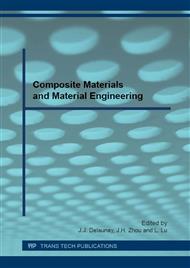[1]
Lehmann, J. Joseph, S., Biochar for environmental management: science and technology. 2012: Routledge.
Google Scholar
[2]
Cheng, C. -H., Lehmann, J., Thies, J.E., Burton, S.D., Engelhard, M.H., (2006). Oxidation of black carbon by biotic and abiotic processes. Organic Geochemistry, 37(11), 1477-1488.
DOI: 10.1016/j.orggeochem.2006.06.022
Google Scholar
[3]
Zhang, X., Wang, H., He, L., Lu, K., Sarmah, A., Li, J., Bolan, N.S., Pei, J., Huang, H., (2013).
Google Scholar
[4]
Glaser, B., Lehmann, J., Zech, W., (2002). Ameliorating physical and chemical properties of highly weathered soils in the tropics with charcoal–a review. Biology and fertility of soils, 35(4), 219-230.
DOI: 10.1007/s00374-002-0466-4
Google Scholar
[5]
Ghaderian, S.M. Ravandi, A.A.G., (2012). Accumulation of copper and other heavy metals by plants growing on Sarcheshmeh copper mining area, Iran. Journal of Geochemical Exploration, 123, 25-32.
DOI: 10.1016/j.gexplo.2012.06.022
Google Scholar
[6]
Rastmanesh, F., Moore, F., Kopaei, M.K., Keshavarzi, B., Behrouz, M., (2011). Heavy metal enrichment of soil in Sarcheshmeh copper complex, Kerman, Iran. Environmental Earth Sciences, 62(2), 329-336.
DOI: 10.1007/s12665-010-0526-2
Google Scholar
[7]
Fellet, G., Marchiol, L., Delle Vedove, G., Peressotti, A., (2011). Application of biochar on mine tailings: effects and perspectives for land reclamation. Chemosphere, 83(9), 1262-1267.
DOI: 10.1016/j.chemosphere.2011.03.053
Google Scholar
[8]
Das, D.D., Schnitzer, M.I., Monreal, C.M., Mayer, P., (2009). Chemical composition of acid–base fractions separated from biooil derived by fast pyrolysis of chicken manure. Bioresource technology, 100(24), 6524-6532.
DOI: 10.1016/j.biortech.2009.06.104
Google Scholar
[9]
Uchimiya, M., Lima, I.M., Thomas Klasson, K., Chang, S., Wartelle, L.H., Rodgers, J.E., (2010).
Google Scholar
[10]
Chen, B., Zhou, D., Zhu, L., (2008). Transitional adsorption and partition of nonpolar and polar aromatic contaminants by biochars of pine needles with different pyrolytic temperatures. Environmental Science & Technology, 42(14), 5137-5143.
DOI: 10.1021/es8002684
Google Scholar
[11]
He, Z., Mao, J., Honeycutt, C.W., Ohno, T., Hunt, J.F., Cade-Menun, B.J., (2009). Characterization of plant-derived water extractable organic matter by multiple spectroscopic techniques. Biology and fertility of soils, 45(6), 609-616.
DOI: 10.1007/s00374-009-0369-8
Google Scholar
[12]
He, Z., Ohno, T., Cade-Menun, B.J., Erich, M.S., Honeycutt, C.W., (2006). Spectral and chemical characterization of phosphates associated with humic substances. Soil Science Society of America Journal, 70(5), 1741-1751.
DOI: 10.2136/sssaj2006.0030
Google Scholar


